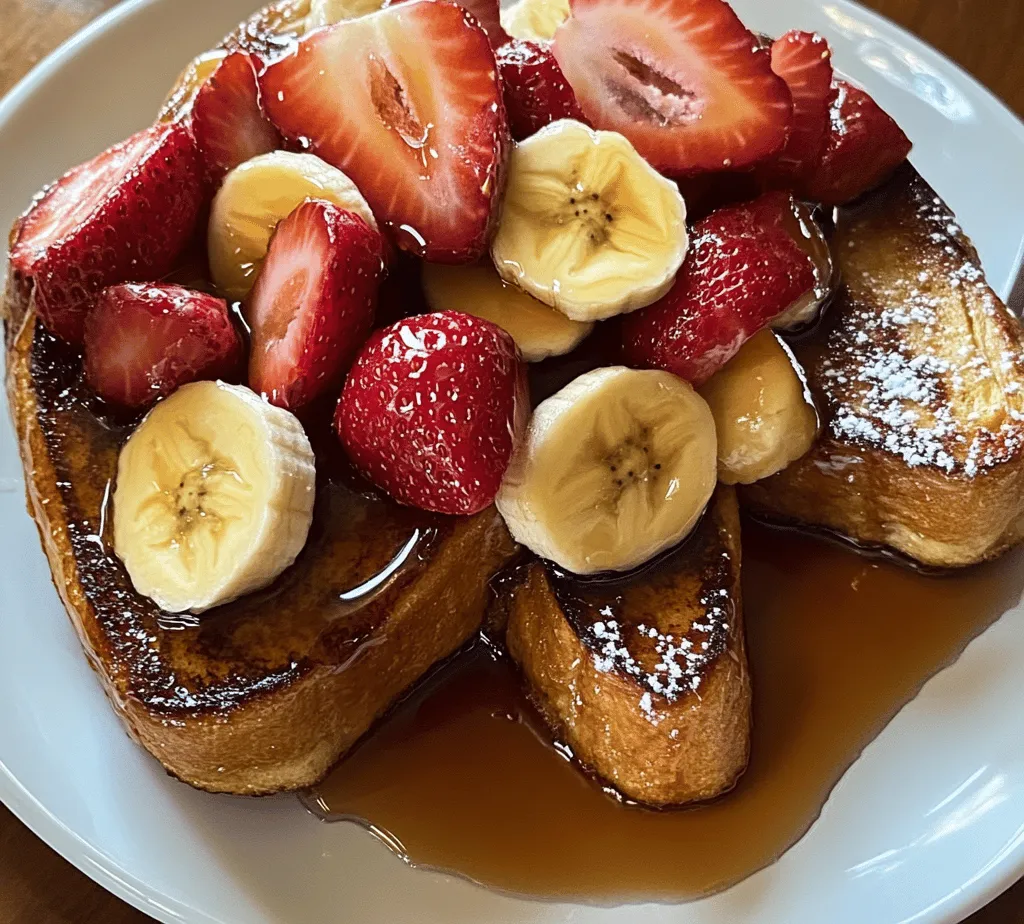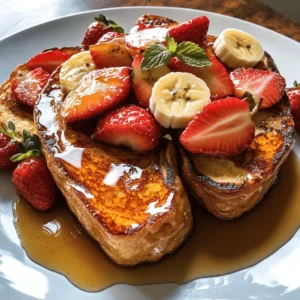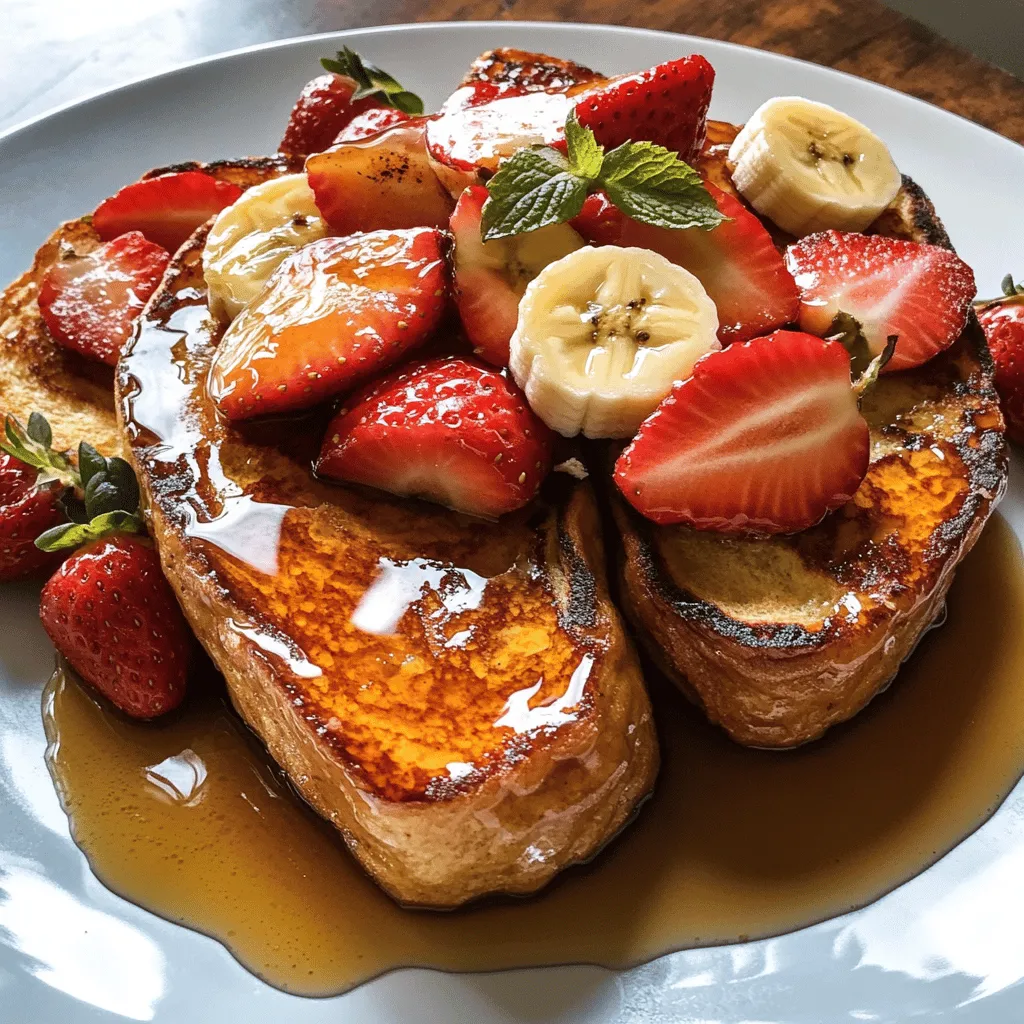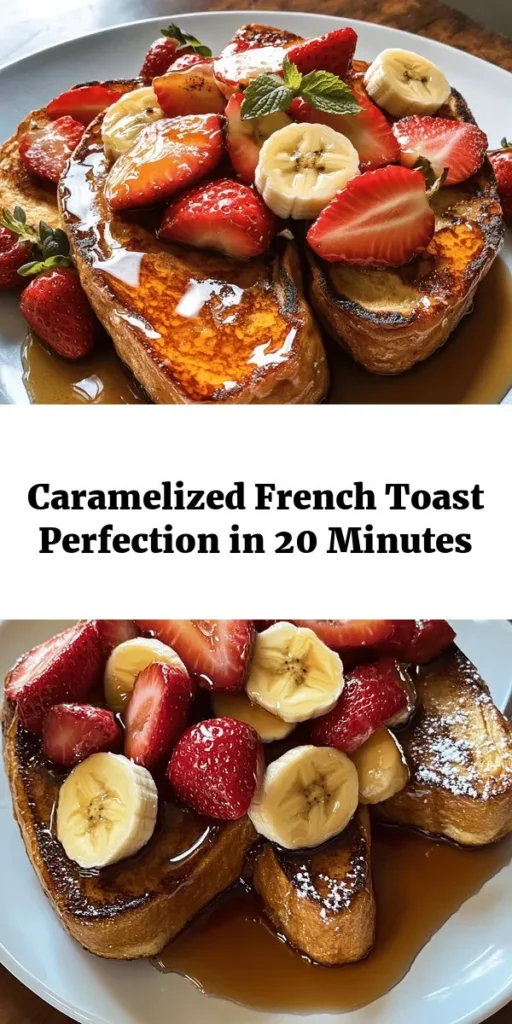Introduction
French toast, known for its delightful combination of flavors and textures, has rightfully earned its place as a beloved breakfast staple across the globe. This classic dish transforms simple ingredients into a warm, comforting meal that can be enjoyed any day of the week. What makes it even more enticing is the process of caramelization, which enhances the natural sweetness of the bread while adding a crispy exterior that contrasts perfectly with a soft, custardy interior.
In this recipe for deliciously caramelized French toast, we will explore a method that not only simplifies the preparation but also guarantees impressive results. With just a few key ingredients and a little bit of technique, you can create a mouthwatering breakfast that is sure to impress your family and friends. Whether you’re a seasoned chef or a cooking novice, this recipe is designed to bring joy to your mornings and savor the delicious flavors that homemade French toast has to offer.
The Allure of French Toast
Historical Context
The origins of French toast can be traced back to ancient civilizations, where bread was soaked in a mixture of milk and eggs and then cooked. The dish has evolved over centuries, with various cultures adding their unique twists. In France, the dish is known as “pain perdu,” meaning “lost bread,” which reflects its purpose of resurrecting stale bread. Other cultures have their versions, such as the Italian “pane di casa” or the Spanish “torrija,” each showcasing local flavors and ingredients.
French toast’s widespread popularity can be attributed to its versatility. It has been embraced as a breakfast staple in many countries, often served with a range of toppings, from fresh fruits and syrup to whipped cream and nuts. This adaptability allows for endless variations, making it a favorite for breakfast enthusiasts worldwide.
Cultural Significance
In many households, French toast is more than just a meal; it represents a cherished tradition. Family gatherings, weekend brunches, or special occasions often feature this comforting dish. The act of preparing French toast can evoke nostalgic memories, whether it’s the aroma wafting through the kitchen or the joy of sitting down to share a meal with loved ones.
Moreover, the cultural significance of French toast extends beyond individual households. It has become a common offering in diners and cafes, showcasing its status as a universally loved breakfast dish. The simplicity of French toast makes it approachable, yet it can easily be elevated to gourmet status, appealing to both casual diners and food aficionados.
Homemade vs. Store-Bought
While store-bought French toast products may seem convenient, nothing compares to the taste and texture of homemade French toast. Homemade versions allow for control over the ingredients, ensuring freshness and quality. The process of making French toast from scratch also allows for personalization—whether it’s selecting your favorite type of bread, adjusting the sweetness, or experimenting with toppings.
Additionally, the homemade approach fosters creativity in the kitchen. You can easily adapt the recipe to suit various dietary preferences or to incorporate seasonal ingredients. With homemade French toast, you have the freedom to create a dish that is uniquely yours, ensuring each bite is a true reflection of your culinary style.
Ingredient Breakdown
To create the perfect caramelized French toast, it’s essential to understand the role of each ingredient. Here’s a breakdown of the key components that will come together to create this delicious breakfast treat.
Thick-Cut Bread
The foundation of any great French toast is the bread, and for this recipe, thick-cut bread is a must. Options like brioche and challah are particularly popular choices due to their rich, buttery flavors and soft textures. Brioche, a French bread enriched with eggs and butter, lends an airy quality that soaks up the custard mixture beautifully. Challah, a Jewish bread, is also slightly sweet and has a tender crumb, making it ideal for French toast.
Choosing the right bread is crucial, as it significantly affects the overall texture and flavor of the dish. Look for bread that is at least a day old, as slightly stale bread will absorb the custard mixture without becoming overly soggy.
Eggs
Eggs are the binding agent in this recipe, playing a vital role in creating the custard that envelops the bread. They contribute to the dish’s creaminess and help achieve that sought-after soft texture. The proteins in eggs coagulate during cooking, creating a satisfying structure that holds the French toast together.
For best results, use large eggs, as they provide the right amount of liquid and richness needed for the custard mixture.
Whole Milk
Using whole milk is essential for achieving richness and flavor in your French toast. The fat content in whole milk enhances the custard’s texture, ensuring a creamy and luxurious mouthfeel. While you might be tempted to use low-fat or skim milk, they won’t yield the same satisfying results.
Feel free to experiment with alternatives like almond milk or oat milk for a dairy-free version, but keep in mind that the overall flavor and creaminess may vary.
Granulated and Brown Sugar
A combination of granulated and brown sugar adds a delightful sweetness to the custard mixture. Granulated sugar provides a straightforward sweetness, while brown sugar contributes a deeper, caramel-like flavor due to its molasses content. This dual sweetness not only enhances the flavor profile but also plays a crucial role during the caramelization process.
When cooking, the sugars in the batter caramelize, creating that beautiful golden-brown crust that is synonymous with perfectly cooked French toast.
Vanilla Extract and Ground Cinnamon
To elevate the flavor of your French toast, vanilla extract and ground cinnamon are indispensable. Vanilla extract adds a warm, aromatic quality that enhances the overall taste, while cinnamon brings a comforting warmth and depth. Together, they create a fragrant custard that envelops the bread and makes the dish feel special.
Unsalted Butter
Butter is a necessity for cooking French toast, and unsalted butter is the best choice for this recipe. This allows you to control the salt content and ensures that the flavors of the custard shine through. Butter not only imparts a rich flavor but also aids in achieving that desirable golden-brown crust during cooking.
Be generous with the butter when cooking, as this will help prevent the bread from sticking to the pan and enhance the overall flavor.
Fresh Fruit and Maple Syrup
Finally, no French toast is complete without its toppings. Fresh fruit, such as berries, sliced bananas, or peaches, adds a refreshing contrast and natural sweetness. Maple syrup is the classic accompaniment, offering a rich, sweet drizzle that complements the caramelized toast perfectly.
Feel free to get creative with your toppings—coconut whipped cream, nuts, or even a dusting of powdered sugar can all elevate your French toast experience.
Preparation Steps in Detail
Now that we have a clear understanding of the ingredients, let’s dive into the preparation process. The following step-by-step guide will ensure you achieve deliciously caramelized French toast every time.
Step 1: Prepare the Batter
Start by gathering all your ingredients and a large mixing bowl. In the bowl, combine the eggs, whole milk, granulated sugar, brown sugar, vanilla extract, and ground cinnamon. Using a whisk, beat the mixture until fully combined and slightly frothy. This whisking technique is important, as it helps to incorporate air, resulting in a lighter texture for the custard.
Step 2: Soak the Bread
Once your batter is well-mixed, it’s time to soak the bread. Take your thick-cut slices of brioche or challah and place them in a shallow dish or directly into the bowl with the custard mixture. Allow the bread to soak for a few minutes—around 2-3 minutes on each side—ensuring that each slice is well-coated. Be careful not to let the bread soak too long, as it can become overly soggy.
Step 3: Heat the Pan
While the bread is soaking, heat a large skillet or griddle over medium heat. Add a generous amount of unsalted butter to the pan, allowing it to melt and coat the bottom evenly. The butter should bubble but not brown; this indicates that the pan is at the right temperature.
Step 4: Cook the French Toast
Once the skillet is ready, carefully place the soaked bread slices in the pan. Cook for about 3-4 minutes on each side or until they develop a golden-brown color. Avoid overcrowding the pan; cook in batches if necessary to maintain even cooking. You may need to adjust the heat to prevent the butter from burning while ensuring the bread cooks through.
Step 5: Check for Doneness
To check if your French toast is fully cooked, gently press the center of a slice with a spatula. It should feel firm but still spring back slightly. If needed, cook for an additional minute on each side until done.
By following these preparation steps, you’re well on your way to creating a beautifully caramelized French toast that will tantalize your taste buds and delight your breakfast table. Enjoy the process, and get ready for a dish that is not only satisfying to make but even more satisfying to eat!

Ideal Soaking Time for the Bread Slices
Getting the soaking time right is crucial for achieving that perfect texture in your deliciously caramelized French toast. Ideally, you should soak the bread slices for 2 to 5 minutes per side. This allows the egg mixture to penetrate the bread sufficiently, ensuring a rich flavor and a custardy center. If you’re using denser bread like challah or brioche, aim for the longer side of this soaking time. However, be cautious; soaking too long can lead to soggy bread that falls apart during cooking.
Tips for Achieving the Perfect Cooking Temperature on the Skillet
The temperature of your skillet can make or break your French toast experience. Preheat your skillet over medium heat; this ensures that the bread cooks evenly without burning. To test if the skillet is hot enough, sprinkle a few drops of water on its surface. If they dance and evaporate quickly, you’re ready to go.
When you add the soaked bread to the skillet, reduce the heat slightly to medium-low. This adjustment allows the egg mixture to cook through while giving you enough time to achieve that beautiful caramelization on the outside. You want a nice golden-brown color without the bread being too dark or undercooked in the middle.
The Caramelization Process: Why Timing and Method Matter
Caramelization is the process of cooking sugar, which occurs when the natural sugars in your bread and the added sugars in the egg mixture begin to brown and develop rich, complex flavors. The magic happens at around 320°F (160°C), where sugars start to caramelize.
To achieve the best results, pay close attention to the timing. As soon as you place the soaked bread on the skillet, start your timer for about 3 to 4 minutes on each side. Flip the bread when you see a rich golden color forming, and ensure that you don’t rush this step. If you flip too early, you risk losing that caramelized crust. A well-timed flip ensures both sides get the chance to develop that exquisite golden hue.
How to Achieve a Golden Crust and the Science Behind Caramelization
The secret to a golden crust lies in the balance of heat and time. As you cook the bread, the sugars in the egg mixture caramelize, creating that delightful crust that contrasts with the soft, custardy interior. To enhance the caramelization process:
1. Use a Non-Stick Skillet: This prevents the bread from sticking and tearing apart during the flipping process.
2. Use Butter or Oil: A combination of butter and a neutral oil (like canola or vegetable oil) can enhance flavor while raising the smoke point, allowing for better caramelization.
3. Avoid Overcrowding the Pan: Cooking in batches ensures that each slice has enough space to sear properly, allowing for even cooking and caramelization.
Understanding these principles will help you master the art of making the perfect caramelized French toast.
Serving Suggestions
Once your French toast is beautifully caramelized, it’s time to think about presentation and pairing to elevate your breakfast experience.
Presentation Ideas That Make the Dish Visually Appealing
A visually appealing presentation can transform a simple dish into a feast for the eyes. Stack your French toast slices neatly, alternating them with fresh fruit or whipped cream. You can drizzle maple syrup or honey over the top and add a dusting of powdered sugar for an elegant touch. Garnishing with a few mint leaves can also provide a pop of color and freshness.
Pairing French Toast with Complementary Beverages
To round out your breakfast, consider serving your French toast with a complementary beverage. A rich cup of coffee or a creamy latte pairs wonderfully with the sweetness of the dish. Alternatively, a refreshing smoothie made with seasonal fruits can provide a bright contrast to the warm, buttery French toast.
Seasonal Fruit Options to Enhance Flavor and Nutrition
Adding fresh seasonal fruits not only enhances the flavor but also boosts the nutritional value of your meal. Consider topping your French toast with berries, sliced bananas, or peaches during the summer. In the fall, apple slices sautéed in a bit of butter and cinnamon can bring a cozy, warm flavor profile that complements the caramelization beautifully.
Creative Variations: Adding Nuts, Whipped Cream, or Flavored Syrups
Don’t hesitate to get creative with your toppings. Chopped nuts like pecans or walnuts add a delightful crunch and contrast to the soft French toast. A dollop of whipped cream can elevate your dish to a decadent treat, while flavored syrups—like vanilla or caramel—can add an extra layer of sweetness. You could also consider adding a sprinkle of cinnamon or a drizzle of chocolate sauce for an indulgent twist.
Nutritional Analysis
As indulgent as caramelized French toast may be, it’s essential to consider the nutritional aspects of this dish.
Breakdown of Nutritional Information Per Serving
A typical serving of caramelized French toast (2 slices) can contain approximately:
– Calories: 350-400
– Protein: 12g
– Fat: 15g
– Carbohydrates: 50g
– Sugar: 15g
These values can vary based on the type of bread used, the amount of butter, and any added toppings.
Discussion on Balancing Indulgence with Nutrition
While French toast is certainly a treat, it can be balanced within a nutritious diet. Consider pairing it with a protein source, like Greek yogurt or turkey bacon, to create a more balanced meal.
Potential Dietary Modifications for Healthier Versions
For those looking to lighten their French toast, there are several modifications you can make without sacrificing flavor:
– Use Whole Grain Bread: This increases the fiber content and offers more nutrients.
– Replace Regular Milk with Almond Milk: A lower-calorie alternative that can also add a hint of flavor.
– Reduce the Sugar: You can often cut the sugar in the egg mixture by half without significantly affecting the taste.
– Opt for Egg Whites: Using egg whites instead of whole eggs can cut down on fat and cholesterol.
The Joy of Cooking Together
Cooking is not only about the final dish; it’s also about the experience and memories created in the kitchen.
Encouragement of Family Involvement in the Cooking Process
Encouraging family members, especially children, to participate in the cooking process can be a wonderful bonding experience. Assign them simple tasks, such as whisking the egg mixture or arranging toppings, to foster a sense of ownership and excitement.
Sharing the Experience of Making Breakfast as a Bonding Activity
Making breakfast together can become a cherished tradition. It’s a time to connect, share stories, and enjoy each other’s company before the day begins. The act of cooking together can lead to laughter, learning, and delightful surprises that make the meal even more special.
Ideas for Making the Cooking Process Fun for Children
To keep children engaged, you can incorporate fun elements like letting them choose their toppings or creating a “French toast bar” where they can customize their servings. Use cookie cutters to shape the bread into fun forms or let them help with the mixing and pouring. This not only makes cooking enjoyable but also teaches them valuable skills.
Conclusion
Creating deliciously caramelized French toast at home is more than just preparing a meal; it’s about crafting experiences and making memories around the breakfast table. This simple yet delightful recipe allows for endless customization and creativity, making it a perfect choice for any occasion.
As you experiment with different flavors and toppings, you’ll find that the joy of cooking extends far beyond the plate. Whether it’s sharing a meal with family, enjoying the satisfaction of homemade goodness, or simply indulging in a sweet treat, each moment spent in the kitchen contributes to a deeper appreciation for food and the connections it fosters.
So gather your ingredients, invite loved ones to join you, and embark on a culinary adventure that celebrates the simple pleasure of cooking together. Your deliciously caramelized French toast awaits!



